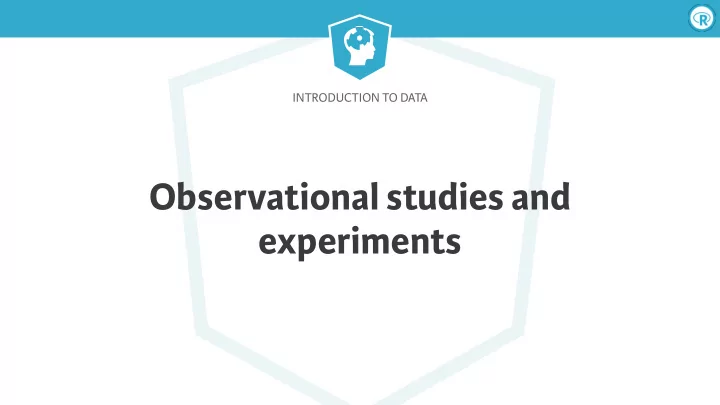

INTRODUCTION TO DATA Observational studies and experiments
Introduction to Data Types of studies ● Observational study: ● Collect data in a way that does not directly interfere with how the data arise ● Only correlation can be inferred ● Experiment: ● Randomly assign subjects to various treatments ● Causation can be inferred
Introduction to Data Design a study Screens at bedtime and a � ention span no screens screens observational average average study attention attention Association? span span screens average attention span experiment Causation? no screens average attention span
INTRODUCTION TO DATA Let’s practice!
INTRODUCTION TO DATA Random sampling and random assignment
Introduction to Data Random… ● Random sampling: ● At selection of subjects from population ● Helps generalizability of results ● Random assignment: ● At selection of subjects from population ● Helps infer causation from results
Introduction to Data Scope of inference Random No random assignment assignment Causal and Not causal, but Random sampling Generalizable generalizable generalizable No random Causal, but not Neither causal nor Not generalizable sampling generalizable generalizable Causal Not causal
INTRODUCTION TO DATA Let’s practice!
INTRODUCTION TO DATA Simpson’s paradox
Introduction to Data Explanatory and response x y (explanatory) (response)
Introduction to Data Multivariate relationships x 1 x 2 x 3 y (explanatory) (explanatory) (explanatory) (response)
Introduction to Data Multivariate relationships calories age fitness heart health (explanatory) (explanatory) (explanatory) (response)
Introduction to Data Simpson’s paradox ● 8 ● ● x2 6 ● 0 ● y ● 1 ● 4 ● ● 2 ● 3 6 9 x1
Introduction to Data Berkeley admission data Admi � ed Rejected Male 1198 1493 Female 557 1278
INTRODUCTION TO DATA Let’s practice!
INTRODUCTION TO DATA Recap: Simpson’s paradox
Introduction to Data Simpson’s paradox ● Overall: males more likely to be admi � ed ● Within most departments: females more likely ● When controlling for department, relationship between gender and admission status is reversed ● Potential reason: ● Women tended to apply to competitive departments with low admission rates ● Men tended to apply to less competitive departments with high admission rates
INTRODUCTION TO DATA Let’s practice!
Recommend
More recommend